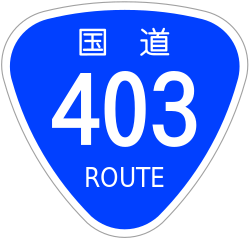Nagano-Autobahn
| Nagano-Autobahn in Japan | |||||||||||||||||||||||||||||||||||||||||||||||||||||||||||||||||||||||||||||||||||||||||||||||||
 | |||||||||||||||||||||||||||||||||||||||||||||||||||||||||||||||||||||||||||||||||||||||||||||||||
| Basisdaten | |||||||||||||||||||||||||||||||||||||||||||||||||||||||||||||||||||||||||||||||||||||||||||||||||
| Betreiber: | NEXCO Naka-Nihon | ||||||||||||||||||||||||||||||||||||||||||||||||||||||||||||||||||||||||||||||||||||||||||||||||
| Weiterer Betreiber: | NEXCO Higashi-Nihon | ||||||||||||||||||||||||||||||||||||||||||||||||||||||||||||||||||||||||||||||||||||||||||||||||
| Gesamtlänge: | 75,8 km | ||||||||||||||||||||||||||||||||||||||||||||||||||||||||||||||||||||||||||||||||||||||||||||||||
 | |||||||||||||||||||||||||||||||||||||||||||||||||||||||||||||||||||||||||||||||||||||||||||||||||
| Beginn der Nagano-Autobahn am Dreieck Okaya | |||||||||||||||||||||||||||||||||||||||||||||||||||||||||||||||||||||||||||||||||||||||||||||||||
Straßenverlauf
| |||||||||||||||||||||||||||||||||||||||||||||||||||||||||||||||||||||||||||||||||||||||||||||||||
Die Nagano-Autobahn (jap. 長野自動車道, Nagano Jidōshadō) ist eine regionale Autobahn in der Präfektur Nagano auf der japanischen Hauptinsel Honshū. Sie bildet das nördliche Teilstück der E19. Sie zweigt am Dreieck Okaya von der Chūō-Autobahn ab und führt über Matsumoto nach Nagano, wo sie am Dreieck Kōshoku auf die Jōshin’etsu-Autobahn trifft.
Zwischen dem Dreieck Okaya und der Anschlussstelle Azumino wird sie von NEXCO Naka-Nihon und zwischen der Anschlussstelle Azumino und dem Dreieck Kōshoku von NEXCO Higashi-Nihon betrieben.
Die Nagano-Autobahn wurde zwischen 1986 und 1993 gebaut. Sie verbindet die Städte Nagano (Haupt- und größte Stadt der Präfektur) und Matsumoto (zweitgrößte Stadt der Präfektur) direkt miteinander und schließt letztere an das japanische Autobahnnetz an. Durch die direkte Verbindung an die Chūō-Autobahn wird der Raum Matsumoto mit den Metropolregionen Tokio und Nagoya verbunden. Ferner ist sie bedeutend für den Fernverkehr von Nagoya nach Niigata.
Anschlussstellen (Interchange)
Okaya (1) – Shiojiri (2) – Shiojiri-Kita (3) – Matsumoto (4) – Azumino (5) – Omi (6) – Kōshoku (7)
Verlauf
Auf dieser Seite verwendete Medien
Wellenlinie als Gewässersymbol für die Formatvorlage Autobahn
Tankstellen-Piktogramm
Zeichen 365-58: Toilette. Das Zeichen ist in den Größen 600x600 sowie 840x840 mm erhältlich und bekam im Jahr 2013 mit einem neuen Verkehrszeichenkatalog eine neue Nummer zugeordnet.
Nach links zeigendes schwarzes Dreieck ◀, U+25C0 aus dem Unicode-Block Geometrische Formen (25A0–25FF)
This is a diagram of Nagano Expwy route sign. This image's glyphs are the outline path from free font that is "GD-HighwayGothicJA(pumpCurry)". If you want to change the glyphs, you MUST check the license of substitute glyphs/fonts.
This is a diagram of Japanese National Route Sign. The glyphs of 国道 are the outline path from free font that is "NARAYAMA Maru Gothic" created by excl-zoo, based on "Wadalab Hosomaru Gothic". If you want to change the glyphs, you MUST check the license of substitute glyphs/fonts.
ja: 日本の国道標識。「国道」のグリフは「和田研細丸ゴシック」を種字とし excl-zoo が作成した「ならやま丸ゴシック」のアウトラインパスである。もし、「国道」のグリフを変更する場合は、変更に使用するフォントのライセンスを確認すること。特にグリフをアウトライン化して埋め込む場合、多くのフォントは商用利用に制限が存在する。
This is a diagram of Japanese National Route Sign. The glyphs of 国道 are the outline path from free font that is "NARAYAMA Maru Gothic" created by excl-zoo, based on "Wadalab Hosomaru Gothic". If you want to change the glyphs, you MUST check the license of substitute glyphs/fonts.
ja: 日本の国道標識。「国道」のグリフは「和田研細丸ゴシック」を種字とし excl-zoo が作成した「ならやま丸ゴシック」のアウトラインパスである。もし、「国道」のグリフを変更する場合は、変更に使用するフォントのライセンスを確認すること。特にグリフをアウトライン化して埋め込む場合、多くのフォントは商用利用に制限が存在する。
This is a diagram of Jōshin-etsu Expwy route sign. This image's glyphs are the outline path from free font that is "GD-HighwayGothicJA(pumpCurry)". If you want to change the glyphs, you MUST check the license of substitute glyphs/fonts.
Zeichen 314-50: Parken. Das Zeichen ist in den Größen 420x420, 600x600 sowie 840x840 mm erhältlich. Die Unternummer wurde im Jahr 2017 gestrichen (nun: Zeichen 314).
This is a diagram of Chūō Expwy route sign. This image's glyphs are the outline path from free font that is "GD-HighwayGothicJA(pumpCurry)". If you want to change the glyphs, you MUST check the license of substitute glyphs/fonts.
This is a diagram of Chubu-Jukan Expwy route sign. This image's glyphs are the outline path from free font that is "GD-HighwayGothicJA(pumpCurry)". If you want to change the glyphs, you MUST check the license of substitute glyphs/fonts.
Motorway Exit Icon in green for left-hand driving areas
Nach rechts zeigendes schwarzes Dreieck ▶, U+25B6 aus dem Unicode-Block Geometrische Formen (25A0–25FF)
This is a diagram of Japanese National Route Sign. The glyphs of 国道 are the outline path from free font that is "NARAYAMA Maru Gothic" created by excl-zoo, based on "Wadalab Hosomaru Gothic". If you want to change the glyphs, you MUST check the license of substitute glyphs/fonts.
ja: 日本の国道標識。「国道」のグリフは「和田研細丸ゴシック」を種字とし excl-zoo が作成した「ならやま丸ゴシック」のアウトラインパスである。もし、「国道」のグリフを変更する場合は、変更に使用するフォントのライセンスを確認すること。特にグリフをアウトライン化して埋め込む場合、多くのフォントは商用利用に制限が存在する。
Autor/Urheber: BMWK1200RS, Lizenz: CC BY-SA 3.0
Nagano Expressway in Okaya, Nagano pref., Japan.
(Autobahn)tunnel (Icon). Gezeichnet nach dem Vorbild schweizerischer Verkehrsschilder.
This is a diagram of Japanese National Route Sign. The glyphs of 国道 are the outline path from free font that is "NARAYAMA Maru Gothic" created by excl-zoo, based on "Wadalab Hosomaru Gothic". If you want to change the glyphs, you MUST check the license of substitute glyphs/fonts.
ja: 日本の国道標識。「国道」のグリフは「和田研細丸ゴシック」を種字とし excl-zoo が作成した「ならやま丸ゴシック」のアウトラインパスである。もし、「国道」のグリフを変更する場合は、変更に使用するフォントのライセンスを確認すること。特にグリフをアウトライン化して埋め込む場合、多くのフォントは商用利用に制限が存在する。




















